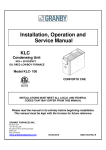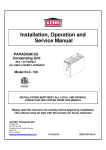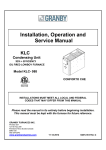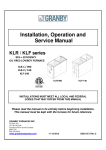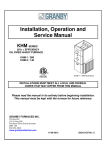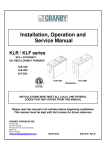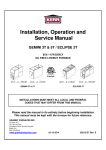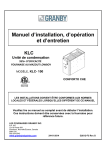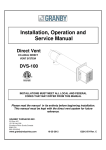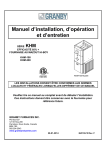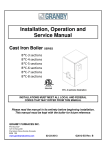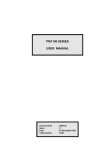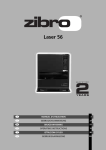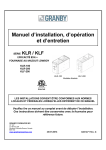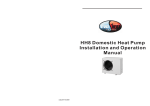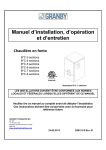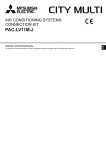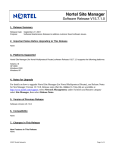Download KLC Manual - 2014-01-24 - E3 Rev G
Transcript
Installation, Operation and Service Manual KLC Condensing Unit 95% + EFFICIENCY OIL FIRED LOWBOY FURNACE Model KLC- 100 CONFORTO CHE INSTALLATIONS MUST MEET ALL LOCAL AND FEDERAL CODES THAT MAY DIFFER FROM THIS MANUAL Please read the manual in its entirety before beginning installation. This manual must be kept with the furnace for future reference. GRANBY FURNACES INC. PO Box 637 12118 Hwy 209 Parrsboro Nova Scotia Canada B0M 1S0 902-254-2543 www.granbyindustries.com 01-24-2014 G2012-E3 Rev.G WARNING This furnace is designed to operate with the ALL 20 flue-pipe baffles correctly installed. The maximum normal flue temperature is 125 Degrees °F after 10 minutes of operation at a maxim um distance of 18 inches from the breach of the unit. IT IS MANDATORY TO MEASURE THE FLUE-PIPE TEMPERATURE, as part of the combustion test, UPON INSTALLATION. This measurement must be taken as close as possible to the breech of the unit, through the plastic flue pipe downstream of the black rubber connector. To do this check, simply make a small hole (large enough for your temperature probe) in the flue pipe. Upon completion of the test, cover the hole with HVAC aluminum tape. If the temperature is OVER 125 Degrees °F: 1. Check that ALL 20 baffles are in place. To do this you must remove the black plastic collector pan as described in section 7.1; 2. Check that the correct nozzle is installed in the burner; 3. Check that you have the correct burner pump pressure; 4. Make sure the blower door is closed during operation; 5. Make sure that the condensate disposal system is not blocked. If that is the case, unblock. IF THE UNIT IS STILL OPERATING OVER 125 DEGREES F AFTER THESE CHECKS, CALL GRANBY FURNACES INC. “CUSTOMER CARE”. PROLONGED OPERATION OVER 125 DEGREES ºF COULD LEAD TO UNSAFE OPERATION, PREMATURE FAILURE OF THE EQUIPMENT AND BODILY HARM. 1 TABLE OF CONTENTS 1.0 IMPORTANT SAFETY ADVICE 3 2.0 PRODUCT INFORMATION 4 3.0 FURNACE INSTALLATION 3.1 PLACEMENT & VENTING 3.2 INSTALLATION CODES 3.3 INSTALLATION INFORMATIONS 3.4 VENTING OPTIONS 3.5 CONDENSATE DRAIN LINE INSTALLATION 6 7 8 8 8 11 4.0 ACCESSORIES INSTALLATION 12 5.0 BURNER INSTALLATION AND SPECIFICATIONS 5.1 ASSEMBLY & INSTALLATION OF THE BURNER 5.2 SET BURNER FOR EFFICIENT OPERATION 5.3 TECHNICAL INFORMATION 13 13 14 16 6.0 FURNACE OPERATION AND SETTINGS 17 6.1 BLOWER SETTING 17 6.2 FAN TIMER CONTROL BOARD (ST9103 A 1028) 18 6.3 (ST9103 A 1028) CONTROL BOARD SEQUENCE 19 6.4 SERVICING – FAN TIMER (ST9103 A 1028) 20 6.5 FLUE AND FRESH AIR PIPE SERVICING 23 7.0 SERVICE AND MAINTENANCE 7.1 CLEANING HEAT EXCHANGER 7.2 BLOWER REMOVA L 23 24 25 8.0 ELECTRICAL / WIRING DIAGRAM 8.1 HEATING & COOLING 8.2 HEATING ONLY 26 26 27 9.0 EXPLODED PARTS VIEW 28 10. START-UP TEST RESULTS 30 2 1.0 IMPORTANT SAFETY ADVICE Please read and understand this manual before installing, operating or servicing the furnace. To ensure you have a clear understanding of the operating procedures of the unit please take the time to read the IMPORTANT SAFETY ADVICE section of this manual. This furnace is equipped with an electronically commutated motor (ECM) for the main circulation blower. The ECM will significantly reduce the electrical power consumption and will enhance home comfort. WARNINGS NEVER burn garbage or paper in the unit. NEVER store combustible material around it. DO NOT attempt to start burner when excess oil has accumulated, when unit is full of vapour or when heat exchanger is very hot. DO NOT use gasoline, crankcase draining’s or any oil containing gasoline. CAUTION DO NOT START THE BURNER UNTIL ALL FITTINGS, COVERS AND DOORS ARE IN PLACE. DO NOT TAMPER WITH THE FURNACE OR CONTROLS, CALL A QUALIFIED BURNER TECHNICIAN. DO NOT STORE OR USE GASOLINE OR OTHER FLAMMABLE VAPOURS AND LIQUIDS IN THE VICINITY OF THIS UNIT OR ANY OTHER APPLIANCE. DANGER Do not use this furnace as a construction heater. Use of this furnace as a construction heater exposes it to abnormal conditions, contaminated combustion air and lack of air filtering. Failure to follow this warning can lead to premature furnace failure which could result in a fire hazard and/or bodily harm and/or material damage. NOTE: DO NOT INSTALL IN SPACE WHERE TEMPERATURE DROPS BELOW 32oF (0oC) FREEZING POINT. CONDENSATE WILL FREEZE AND WILL DAMAGE UNIT. IMPORTANT This manual contains instructional and operational information for the KLC OIL-FIRED FURNACE. Read the instructions thoroughly before installing furnace or starting the burner. Consult local authorities about your local FIRE SAFETY REGULATIONS. All installations must be in accordance with local state or provincial codes. Improper installation will result in voiding of warranty. 3 2.0 PRODUCT INFORMATION CLEARANCE (minimum) TO COMBUSTIBLES Top of Supply Plenum 1” (25 mm) Front (Maintenance) 24” (610 mm) Rear (Maintenance) 24” (610 mm) Side – Non-Access 1” (25 mm) Side – Access maintenance 24” (610 mm) Vent Pipe 0” (0 mm) Floor (Can be installed directly on combustible or non-combustible) AIR/BLOWER DATA Maximum external static pressure Maximum cooling unit capacity Maximum air temperature rise High Limit temperature Thermostat anticipator 0.5” wc 3.0 tons. See pages 16 and 31 215°F See thermostat instructions MOTOR/BLOWER KLC-100: 1/2 hp ECM / GT12-10 FAN/HIGH LIMIT CONTROL Honeywell ST9103A1028 Fan Center & Thermo-Disk (7” stem) THERMOSTAT Any wall thermostat FUEL Not heavier than No. 2 furnace oil. ELECTRICAL – 120 Volts, 60 Hz Canada Less than 12 amps, circuit protection 15 amps. USA 13.3 amps, circuit protection 20 amps. VENT PIPE CONNECTION 3’’ IPEX 636 CONDENSATE DRAIN PLASTIC HOSE ½’’ diameter CLEANOUTS Rear Cover & Burner Opening 4 AIR FILTER KLC-100 2 x 12” x 20” x 2” non pleated UL approved PLENUM DIMENSIONS KLC-100 CONFORTO Cold air return (A) 20” x 20” (508 x 508 mm) Hot air supply (B) 20” x 20” (508 x 508 mm) Plenum spacing (C) 3” (76 mm) KLC-100 - DIMENSIONS Dimensions are in inches 5 3.0 FURNACE INSTALLATION OIL TANK & PIPING Tank installation must conform to local requirements. Install according to the applicable code such as CSA B139 and NFPA 31. Minimize number of connections in suction line and make all connections air tight. Use a pipe joint compound suitable for oil on all pipe threads. To reduce possibility of air leaks, tighten stem packing gland nut on any valves installed in the suction line. Also, be sure the oil filter is tight, as filter gaskets often shrink. Check for kinks in the oil lines as well as for possible air pockets and for loose connections. Two filters as shown below are recommended. Optional tank gauge protectors and outlet protectors are available at your local dealer. ONE PIPE SYSTEM Where the tank outlet is above the burner and when the oil flows by gravity to the oil pump, a single-stage fuel unit with a single oil line to the pump may be used. TWO PIPE SYSTEM When a single line is not suitable, use double line or contact your dealer for special oil line fittings. Install by-pass plug on burner fuel pump as specified in the burner manual. Rear Flue Furnace illustration See page 9 for vent options installation. Oil Tank and Piping 6 3.1 PLACEMENT & VENTING Furnace installation shall conform to the required installation code for oil-fired equipment (USA: NFPA 31, Canada: CSA B139). FLOOR SUPPORT COMBUSTIBLE – If required, support furnace on five (5) concrete blocks. Make sure the center of the furnace base is supported. For a furnace installed on a combustible floor, consult the applicable code and authorities having jurisdiction on this application. The floor must support the weight. VENT The KLC can be vented vertically through the roof or horizontally through the wall. The appropriate venting material must be rated to a minimum operating temperature of 65oC (149oF). The approved vent material is ULC IPEX S636 PVC-40 in Canada and IPEX S636 PVC-40 (or its equivalent) in the United States. Keep vent/flue pipe as short as possible with a minimum. 1/4” per foot upward slope. See section 5.3 for more information. . WARNING BE AWARE THAT REMOVING BAFFLES REDUCES THE UNIT’S EFFICIENCY AND INCREASE THE OUTLET TEMPERATURE. A MODIFIED UNIT IS NO LONGER ENERGY STAR APPROVED. THIS COULD RESULT IN FIRE HAZARD AND/OR OTHER HAZARDOUS CONDITIONS THAT MAY LEAD TO BODILY HARM. COMBUSTION & VENTILATION AIR Install openings and ductwork to the furnace room providing fresh outside combustion and circulation air for cooling the furnace casing, as installation code requires (USA NFPA 31, Canada CSA B139). If installed in a closed room, provide two free air ventilation openings of at least 8” x 12” (96 sq. in.) free flow area near ceiling and floor. Oil burners must have sufficient air to allow vent systems to operate properly. If balance flue burner his used, combustion air must be duct to the outside as per instructions. ELECTRICAL Wire according to the National Electrical Code (Canadian or USA) or local codes. Use a separately fused #12 electrical line directly from the service panel to the furnace junction box. Install a manual shut-off switch at the door or stairway to furnace room so furnace can be shut off remotely. CLEARANCES Before placing unit, review installation clearances as shown on furnace operating decal or section PRODUCT INFORMATION (page 4). 7 BLOWER DOOR Do not operate without blower door properly installed. This could result in fire hazard and/or hazardous conditions that may lead to bodily harm. 3.2 INSTALLATION CODES INSTALLATION MUST COMPLY WITH THE REQUIREMENTS OF AUTHORITIES HAVING JURISDICTION. . All local and national codes governing the installation of oil burning equipment, wiring and venting must be followed. Some of the applicable codes are: CAN/CSA B 139 NFPA 31 ANSI/NFPA 90B ANSI/NFPA70 CSA C 22.1 ANSI/NFPA 211 Installation Code for oil burning Equipment Installation Code for Oil Burning Equipment Warm Air Heating and Air Conditioning Systems National Electrical Code Canadian Electrical Code Chimneys, Fireplaces, Vents and Solid Fuel Burning Appliances The latest versions of the above codes that have been approved for use in the location of the installation must be used. 3.3 INSTALLATION INFORMATIONS VENT PIPE See NFPA 31 (USA) or CSA B139 (Canada) code. Breech is certified for 3’’ ULC IPEX S636 PVC-40 vent pipe in Canada and IPEX S636 PVC-40 (or its equivalent) in the United States The appropriate venting material must be rated to a minimum operating temperature of 65oC (149oF). See section 5.3 for more technical information. RETURN AIR Ensure that the furnace return air temperature to the unit is not lower than 50oF (10oC) 3.4 VENTING IPEX System 636 in 3 inch diameter is recommended for the KLC. The Installation Methods to be used are detailed in the manual available at : http://www.ipexinc.com . An online Solvent Cementing Course is also available at that site. The minimum vent linear length is 5 feet. The maximum horizontal equivalent length allowed is 80 feet. Each 90o elbow accounts for 8 feet. As an example if the system has 5 elbows, 40 linear feet of vent can be used. The vent is connected to the furnace using the supplied neoprene coupling. 8 VENTING OPTIONS INSTALLATION TWO PIPES SYSTEM COAXIAL SYSTEM Two small openings of 3’’1/2+ Single opening of 4’’1/2+ BF3 Riello burner approved BF3 Riello burner approved VERTICAL ONE PIPE SYSTEM Especially for retrofit installation Easy to fit one pipe in 7”x7” chimney tile Avoid wall opening No clearance restriction Perfect where there is no access to external wall in the mechanical room F3 Riello burner approved 9 WALL TERMINAL INSTALLATION REQUIREMENTS In Canada Refer to the CSA B139 Code for the placement of the vent termination In United States Refer to the NFPA31 Code for the placement of the vent termination COAXIAL WALL CLEARANCE TWO PIPES WALL CLEARANCE All piping must be on same wall 0utlet termination clearance above grade and roof overhang Check flue and combustion air pipes for any leak VENT TERMINATION WARNING It is the responsibility of the homeowner to ensure that the area around the vent terminal and air intake is free of snow, ice and debris. The vent terminal should be checked during heavy snowstorms to ensure proper operation. 10 3.5 CONDENSATE DRAIN PIPE INSTALLATION Drain Trap Assembly Overview The condensate drain tube must have a downward slope to the drain of the residence to provide a flow free of any resistance. Before starting the unit add water Inside the collector pan through the breech hole (3’’). Add enough water so that you see water coming out the tube coming out from the furnace. Floor drain or condensate pump reservoir “ Not to do” Do not add a ‘’P’’ trap on the condensate drain tube Floor drain or condensate pump reservoir BEWARE NOT TO CREATE A ‘KINK’ IN THE CONDENSATE DRAIN TUBE IMPROTANT Please note that the warranty to this product may be void if damages to the furnace heat exchanger are caused by blockage of the condensate fluid evacuation system. It is the responsibility of the installer, service technician and homeowner to make sure that nothing can obstruct the evacuation of the condensate fluid from the furnace. The condensate fluid neutralizer cartridge must be changed annually and the condensate fluid evacuation system must also be verified annually for proper functioning. Floor drain Or condensate pump reservoir 11 4.0 ACCESSORIES INSTALLATION AIR CONDITIONING SYSTEM OUTSIDE CONDENSER UNIT INSIDE EVAPORATOR COIL An air conditioning evaporator coil may be installed on the supply side only. Coils installed on the return side will cause damage on the unit; this will shorten the unit life and may cause products of combustion to enter the house. Wire as per wiring label and diagram. Height of the coil above the unit supply shall be at least 4” (102 mm). See A/C coil Manufacturers Requirements. To check the AC coil total air flow resistance, see procedure at page 31. HUMIDIFIER If a humidifier is installed ensure that no water can drip or run from it into the furnace. This would cause deterioration and void the furnace warranty. 12 5.0 BURNER INSTALLATION AND SPECIFICATIONS 5.1 ASSEMBLY & INSTALLATION OF BURNER ASSEMBLY Check that the burner model is correct for furnace rating required. Assemble as per burner manufacturer’s instructions. SELECT NOZZLE Select oil input, nozzle and burner configuration as shown on furnace operating decal. INSTALL NOZZLE Install selected nozzle, check for clean seating and tighten in nozzle adaptor. ELECTRODES See burner manufacturer’s instructions for correct setting INSERTION MOUNT BURNER Tighten top nut first so burner tips down slightly. The burner is always installed in an upright position by four (4) nuts. PUMP BY-PASS PLUG For one pipe system factory setting (no plug). PRESSURE TUBE BF3 BURNER – 2 PIPES (IPEX) VENTING THE PRESSURE TUBE MUST BE CONNECTED ON THE APPROPRIATE LOCATION (TOP RIGHT) ON THE BURNER CASING. F3 BURNER – 1 PIPE (IPEX) VERTICAL VENTING THE PRESSURE TUBE MUST BE CUT AT THE EXIT OF THE ELECTRICAL BOX. IT SHOULD MEASURE ATMOSPHERIC PRESSURE. WIRING Refer to wiring diagram for correct burner connections (see page 26). THERMOSTAT Connect the thermostat wires to the fan timer control board (ST9103). 13 5.2 SET BURNER FOR EFFICIENT OPERATION BURNER SETTING Use burner settings in the table on page 16 or operating decal as a guide to set burner, particularly for nozzle changes. Those settings are only starting points for the adjustments and are not meant as final settings. PUMP PRESSURE Refer to the table on page 16 or operating decal. AIR SETTING Use air settings on page 16 as a guide to set air adjustment. Those settings are only starting points for the adjustments and are not meant as final settings. SAMPLING HOLE A sample hole is required for the burner set-up. Drill 3/8’’ diameter hole on top of the vent pipe and use the supplied test port plug to seal after burner setup. Rear Flue Furnace illustration Sampling Hole See page 9 for venting options. COMBUSTION TEST: ANALYZER All your tests must be done with the burner cover on Use an electronic gas analyzer for setup and record information on the furnace setup decal. Failure to do so may void warranty. Always set flame with proper draft, smoke and CO2 measurements. NOTE: Some electronic gas analyzers do not account for recovery of latent heat and give low efficiency readings. Use the table below to determine the AFUE. Nozzle Size Usgph 0,50 0,60 CO2 Concentration % 11.5 12.5 Stack Temperature ο F 98 TO 108 109 TO 115 AFUE % 95,4 95,4 14 COMBUSTION SETTING/ EFFICIENCY After 10 minutes of normal operation, take a smoke test and adjust the burner to obtain a reading of “1” on the smoke scale. . To reach the maximum smoke test value, a 10 full slow steady pump action is required. Take a CO2 test and note the result. CO2 test can be done mechanically or electronically (18 full slow steady pump action) Open the air band on the burner to reduce your CO2 lecture by 1.5% with a two pipes installation. On a one pipe installation reduce your CO2 by 1%. You now have a perfect “ 0 ” of smoke Relation between % of CO2 and O2 CO2 (%) O2 (%) Excess Air (%) 13.5 13.0 12.5 12.0 11.5 2.6 3.3 4.0 4.6 5.3 15.0 20.0 25.0 30.0 35.0 11.0 6.0 40.0 15 5.3 TECHNICAL INFORMATION KLC- 100 Two pipes Venting One pipe Venting BF3 Riello Riello Burner Unit Model Firing Rate (USGPH) Input (BTU/h) Output (BTU/h) Nozzle Pump Pressure (psi) Turbulator Setting Air Gate Adjustment Energy Star Approved AFUE (%) CO2 (%) F3 Riello KLC-V1-*073-03 KLC-V1-*088-03 KLC-E1-*073-03 KLC-E1-*088-03 0.55 77,000 74,000 0.50 70W 145 0 3.75 YES 95.8 11.5 0.65 91,000 87,000 0.60 70W 145 0 4.50 YES 95.8 12.5 0.55 77,000 74,000 0.50 70W 145 0 2.50 YES 95.8 11.5 0.65 91,000 87,000 0.60 70W 145 0 3.25 YES 95.8 12.5 General Information (*) In the Unit Model number, is specific information of the product for administration only. Energy Star ECM motor (0.2’’ wc to 0.5’’wc ) Temperature Rise (°F) Blower Speed 52-85 58-85 52-85 58-85 MEDIUM MEDIUM MEDIUM MEDIUM Static Pressure Blower ECM 1/2 hp Speed 0.2" wc 0.5" wc HI 1300 1230 MHI 1225 1160 MED 1140 1050 MLO 1025 980 LO 775 750 Approved Vent ( Pipe must be rated for a minimum of (149oF) operating temperature). Model of KLC Vent configuration & Vent material Combustion Air Maximum vent length Vent KLC-V1 Concentric & 2 pipes system Canada: IPEX S636 PVC-40 USA: CPVC schedule 40 or equivalent From outside the stucture 80’ equivalent horizontal 3" KLC-E1 Vertical / 1pipe system Canada: IPEX S636 PVC-40 USA: CPVC schedule 40 or equivalent From inside the structure 50’ equiv. horizontal +vertical vent. 3’’ 16 6.0 FURNACE OPERATION AND SETTINGS SHUTTING FURNACE DOWN POWER OFF Turn off main power breaker or disconnect. FUEL OFF Shut off manual fuel supply valve. Always keep manual fuel supply valve shut off if the burner is shut down for an extended period of time. RESTARTING FURNACE Follow this procedure before restarting a unit that has been shut down for an extended period of time. INSPECTION Have the furnace/system serviced and inspected by a qualified technician. FUEL Turn on fuel supply and check that there are no leaks. POWER Turn on power and check that the furnace starts and operates as usual. OPERATION If the furnace/system fails to operate or operates in an unusual manner, call your service technician. If the burner fails to operate at any time, call a qualified burner technician. 6.1 BLOWER SETTING Ensure power is off when adjusting blower setting. For heating, use the blower speeds shown on the furnace specifications to give a temperature rise according to the technical information tables on page 16. The Lo blower speed can be used for air circulation when heating or cooling are not required. Set blower speeds to match the installation requirements. FAN & LIMIT CONTROL Limit Fan On Fan Off 215°F – Factory set 45 seconds after the burner starts Adjustable on board (see page 18) THERMOSTAT ANTICIPATOR SETTING Adjust to thermostat manufacturer’s instruction 17 6.2 FAN TIMER CONTROL BOARD (ST9103A 1028) o “FAN OFF” Dip Switches adjustment Dip Switches COMFORT ADJUSTMENTS o Outlet air consistently too warm or too cold - change the blower motor speed to give the specified air temperature rise. o Outlet air gets too warm and burner shuts down - increase air by changing the blower motor speed to give the specified temperature rise. o Outlet air is too cold or too warm at the end of the heating cycle after the burner has turned off - adjust the “FAN OFF” dip switch on fan timer control board. Refer to the next figure. “FAN OFF” Dip Switch Dip Switch adjustment (90 seconds) on all input OFF CYCLE AIR CIRCULATION (Factory settings) LO SPEED All KLC models have the Lo speed switch for optional constant air circulation during the furnace off cycle. “FAN ON” When “FAN ON” is selected on the thermostat, the blower will run constantly at the blower speed selected on the heating terminal. This is the equivalent of jumping terminals R and G on the ST9103 board. 18 6.3 ST9103A 1028 CONTROL BOARD SEQUENCE ST9103 Heating Sequence 1) 2) 3) 4) 5) Thermostat calls for Heat. Burner starts Blower starts after 45 seconds Burner shuts down after call for heat is satisfied Blower stops according to adjusted (FAN OFF) Dip switch selection ST9103 Cooling Sequence 1) 2) 3) 4) 5) Thermostat calls for cooling Blower starts immediately Cooling unit starts Blower stops immediately after cooling demand is satisfied Cooling unit stops Honeywell ST9103A 1028 Electronic Board 19 6.4 SERVICING - FAN TIMER ST9103A1028 Trouble shooting the Honeywell electronic board ST 9103 Before trouble shooting the board, check for the 5 amp. fuse For accurate trouble shooting, follow step by step the Trouble Shooting Chart. Step Possible Cause Check-out procedure Corrective action No Heat 1 Incoming supply Check for 120 Volts between terminal S2 and 3 on electronic fan control Check for 120 Volts between terminal S3 and 4 on electronic fan control. Check for 24 Volts between terminal X and C on electronic fan control Check for 24 Volts between R and C Check for 24 Volts between terminal W and C Yes - Move to next step No - Check breaker main power switch Yes - Move to next step No - Check for bad connection Yes - Move to next step No - Change Transformer 2 Transformer 3 Electronic Fan control 4 Warning: Make sure the quick connect cable is fully inserted on the board Yes - Move to next step No - Change the electronic board Yes - Move to next step No - Check thermostat and wiring Check for 120 Volts on each Yes - Move to step # 5 terminal of the two limits No - Move to next step Limit Control Check for 120 Volts coming from the main plug-in of the electronic fan control to the limit control Yes - Move to next step No - Change the electronic fan control Check for 120 Volts coming out of the limit control Yes - Move to step # 5 No - Failure on the limit control circuit . Temperature too high . Bad limit control 20 Step Possible Cause Check-out procedure Corrective action No Heat 5 Riello burner Yes - Move to next step Check for 120 Volts on the black wire, contact (COM) on No - Back to step # 4 or check for bad the burner activation relay. connection Check if oil primary control is Yes - Press reset button No - Move to the next step on reset Check for 24 v. coming from the electronic fan control to the condensate overflow switch Blower . Low speed Check if the constant low speed switch is ON 6 Yes - Move to next step No - Change the electronic fan control Check for 24 v. coming from the condensate overflow switch to the burner activation relay Yes - Move to next step No - Check condensate overflow switch Check for 24 v. on coil terminals of the burner activation relay. Yes – Move to next step No - Change the burner activation relay Check for 120 Volts on the contact (No) of burner activation relay Yes - Move to next step No - Change the burner activation relay Check for 120 Volts on terminal # 1 of the bypass timer relay. (15sec.) Yes - Move to next step No - Change the relay, check for 120v. on pressure switch terminals. Check for 120 volts on the orange wire coming to the burner (L) Yes - Failure on the burner No - Change the electronic control Check for 120 Volts at the ''CONT'' terminal on the electronic fan control Yes - Move to next step No - Change the electronic fan control Check for 120 Volts on both side of the constant low speed switch Yes - Check ''LOW'' speed on the blower motor No - Change the switch Check for 120 Volts at the '' Heat'' terminal of the electronic fan control Yes - Check ''HEAT'' speed on the blower motor No - Change the electronic fan control . High speed (wait for the seconds delay ''DIP'' switch adjustments on the board) 21 Step Possible Cause Check-out procedure Corrective action No Cooling 7 Blower High speed . Yes - Move to next step Check for 24 Volts between G No - Check thermostat and wiring; if and C on electronic fan control it's OK, then change the electronic fan control Check for 120 Volts at the ''COOL'' terminal of the electronic fan control 8 Condensing unit Check for 24 volts between terminal Y and C on the electronic fan control Yes - Check ''COOL'' speed on the blower motor No - Change the electronic fan control Yes - Compressor ON No - Check thermostat and wiring Electronic air filter and Humidifier 9 10 Electronic air filter Check for 120 Volts on terminal ''EAC'' of the Yes - Electronic filter failure electronic fan control (thermostat must call a Heat, No - Change the electronic fan control Cool or Fan ON demand Humidifier Check for 120 Volts on Yes - Humidifier failure terminal ''HUM'' of the electronic fan control (burner No - Change the electronic fan control must be energized) If the Honeywell electronic fan control (ST9103A1028) is defect, replace the control with the same part recommend by Granby Industries Part #... 4CB-00-FAN0-00 22 6.5 Flue and Fresh Air Pipe Servicing To facilitate servicing, use 3 neoprene couplings when installing the plastic pipes 1 Neoprene coupling for the fresh air pipe Fresh air pipe Flue pipe #636 2 Neoprene’s couplings for the flue pipe 7.0 SERVICE AND MAINTENANCE REGULAR MAINTENANCE Check complete operation at least once a year. In Canada see B139, (Maintenance), in Unites States see NFPA 31, for recommended servicing procedure. Clean flue pipes on a regular basis. Check flue and combustion air pipes for any leak. CHANGING NOZZLE It is recommended that the nozzle be replaced once a year. If a new nozzle of a different size is installed, change the blower speed according to section BURNER INSTALLATION AND SPECIFICATIONS or operating decal as required. 23 7.1 CLEANING HEAT EXCHANGER Heat exchanger must be inspected every heating season. Refer to instructions and pictures below. Step 1: Remove top rear panel and condensing pan Step 4: Remove burner Step 2: Remove baffles Step 3: Clean the round tubes, if needed (use a 1-1/4’’ diameter brush) Step 5: Clean combustion chamber, if needed Do not forget to put back the baffles • IMPORTANT SEE WARNING PAGE 7 See page 11 CONDENSATE NEUTRALIZER The neutralizer canister should be replaced once per year or for every 600 USG (2300L) of oil used in the furnace. The condensate from the furnace is slightly acidic with a pH of about 4; a neutral fluid would have a pH of 7. If the condensate is not conditioned, damage could result in waste water handling system which would result in expensive repairs. A replacement neutralizer cartridge can be acquired from your local dealer. During the first hours of operation. The appliance self-cleans its interior. The result being that for the first 20 hours of activity, the condensate liquid will be brownish and thereafter stabilize and become of normal ‘’water’’ color. AIR FILTERS To maintain furnace performance and safety, replace dirty filters at least once every heating season or as required. Use new approved disposable filters of the same size and type. Dirty, clogged or wrong sized filters will impair the furnace performance and may cause the furnace to shut down or overheat. 24 7.2 BLOWER REMOVAL This furnace has a blower sealing system, which is designed to be tight and rattle free. Refer to the instructions and pictures below. 1) 2) 3) 4) 5) Shut off oil and power to furnace. Open blower compartment. Disconnect the wiring to the blower motor. Remove the air filter and the condensate neutralizer. Remove the four (4) wing nuts securing the blower side to the base panel bracket. Wing Nuts 6) Slide the blower toward you and then lift the blower straight up. Shift the blower out of the furnace. 7) Put back the blower assembly using the reverse procedure. Ensure wiring and ground wire are correctly reconnected. 25 8.0 ELECTRICAL / WIRING DIAGRAM 8.1 HEATING & COOLING The condensate overflow switch is inside the rear black plastic condensate collector. It is a normally automatic reset contact. NOTE 1 2 wires thermostat wiring diagram see page 27 26 8.1 HEATING ONLY The condensate overflow switch is inside the rear black plastic condensate collector. It is a normally automatic reset contact. 27 9.0 EXPLODED PARTS VIEW KLC-100 CONFORTO Exploded Parts View 28 KLC-100 – Conforto Part List ITEM PART NUMBER DESCRIPTION QTY 1 2 3 4 5 6 7 8 9 10 11 12 13 14 15 16 17 18 19 20 21 22 23 24 25 26 27 28 29 30 31 32 CAB-A0-0047-00 CAB-A0-0031-00 CAB-A0-0032-00 CAB-A0-0033-00 CAB-A0-0046-00 CAB-P0-0022-00 3HN-00-PULL-00 CAB-P0-0018-00 CAB-P0-0248-00 CAB-P0-0143-00 CAB-P0-0012-00 3CN-02-0375-00 CAB-P0-0246-00 3HC-12-COLL-00 3GK-18-COLL-00 HEX-A0-0008-00 INS-P0-0038-00 HEX-A0-0002-00 3AF-02-1220-01 INS-P0-0018-00 INS-P0-0017-00 3SG-0P-1030-5A 4SD-00-0215-00 ELB-P0-0018-00 ELB-A0-0022-00 4CB-00-FAN0-00 4TF-00-40VA-00 4RY-00-24V0-00 4RY-BP-0175-15 4SW-PS-9370-55 FAN-A0-0005-01 3BU-12-07DD-00 Front Panel Assembly Left Panel Assembly Right Panel Assembly Divider Panel Assembly Base Panel Assembly Top Rear Panel Handle Flush Pocket Pull Blower Door Panel Upper Divider – Part 2 Upper Divider Insulation Support Tube Condensate Neutralizing 2GPH ½ NPT Condensing Backing Plate Collector Heat Exchanger Gasket Condensing Collector 3/16’’ HT Neoprene Pipe Baffle 1.5in Assembly Divider Filler Gasket – 20 Holes Condensing Heat Exchanger Assembly Filter Air 12'' x 20'' x 2'' Non-Pleated (Strata Type) Sight Glass Insulation Burner's Flange Insulation Glass Sight Clear 1'' NPT Hex With THD Seal High Limit Snap Disc (215°)Auto R eset #36T01B7 47655 Cover Electrical Box – Low Boy Model Electrical Box Assembly – Low Boy Condensation ST9103A1028 Electronic Board Transformer HTC-01A0BB01 40 VA Relay AE04001 24VAC Form C SPDT 24V Timer Bypass NC 15 Second Delay MPL NC Pressure Switch 0.55 inches Fan Motor Assembly KLC ECM Motor Blower DC 1220 Fwd-curved Direct Drive 1 1 1 1 1 1 1 1 1 1 1 1 1 1 1 20 1 1 2 1 1 1 1 1 1 1 1 1 1 1 1 1 33 3BM-50-ECM0-02 Motor Blower ½ HP ECM Ecotech EMERSON 1 34 1SB-00-BUMR-02 Bracket Long Motor Mounting Direct Drive Blower 1 29 10. START-UP TEST RESULTS Model: Serial Number: Date of installation: Installer (name & address): START-UP TEST RESULTS Size of unit (Btu/h): Nozzle: Oil Pressure (psi): Burner adjustments: RIELLO F-3 _______ RIELLO BF-3________ Turbulator: Air Gate: Venting type installation: Two pipe system______ Smoke result: Coaxial System ______ #0 Combustion Results: Vertical one pipe system ________ TRACE__________ CO2 % Excess air (%) _________________ Efficiency (%) Ambient temperature: °F Gross flue temperature: °F Temperature rise: °F (see page 31) External total static pressure: “ W.C. (see page 31) A/C Coil total resistance: “ W.C. (see page 31) 30 TEST PROCEDURES External Total Static Pressure Reading Total Static Pressure = Supply Pressure (Ps) + Return Pressure (Pr) Pr Ps A/C Coil Total Resistance Reading A/C coil total resistance = Coil Pressure (Pc) - Supply Pressure (Ps) Ps Pr Pc Temperature Rise Reading *** Temperature rise = Supply Temp. (Ts) - Return Temp. (Tr) Tr Ts *** Probe must not be in direct sight of heat exchanger. 31 Granby Furnaces Inc. manufactures a full line of oil-fired furnaces in its 70,000 square feet facility. Granby products are sold across Canada and the United States through a distribution network. Our team of engineers, designers and technicians continually research and develop products to go beyond the demanding specifications of today’s certifications. Thank you for choosing Granby. Granby. 32

































